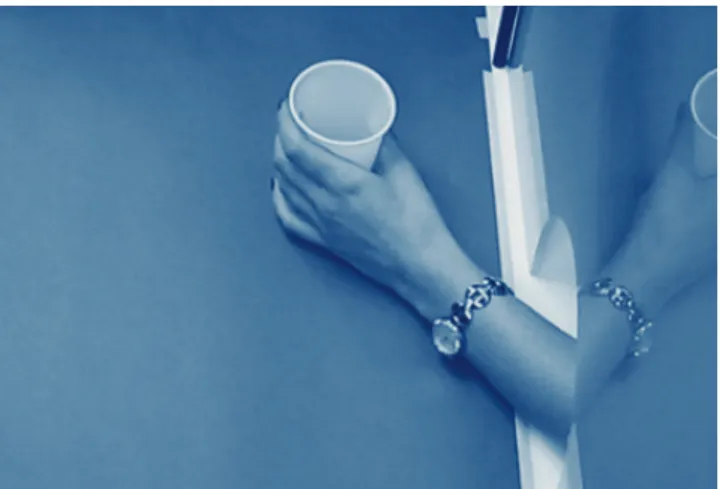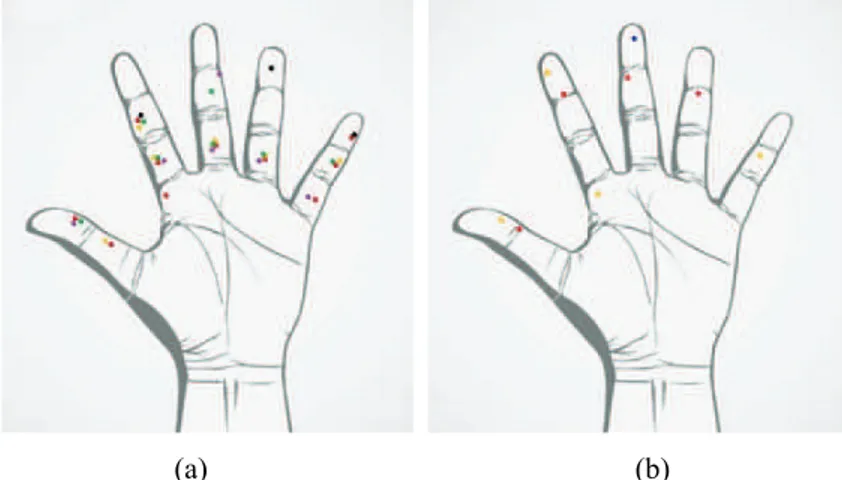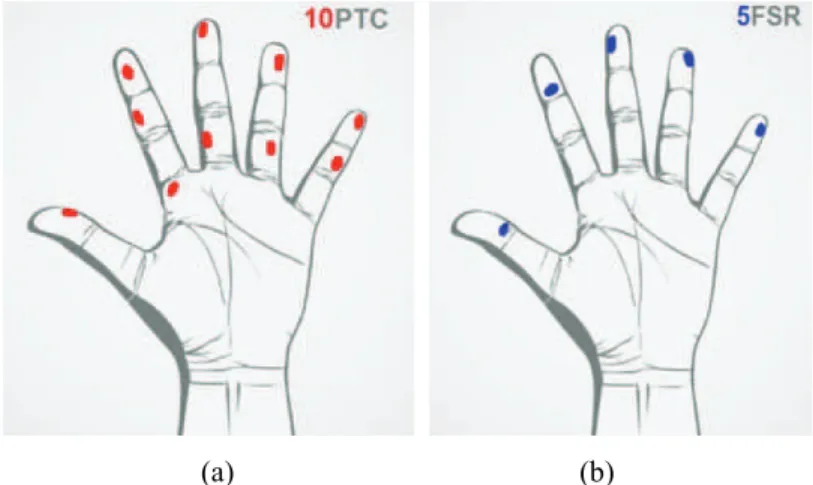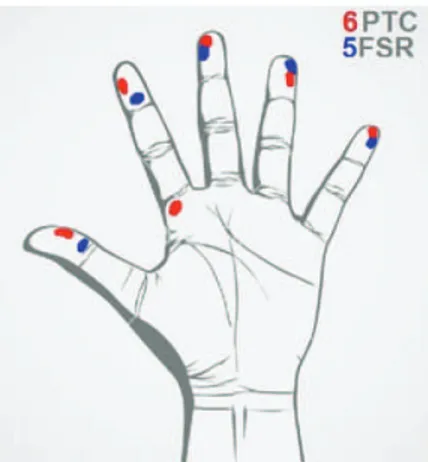Prosthetic Hand Sensor Placement: Analysis of
Touch Perception During the Grasp
Bojana Mirkovi
ć
1, Dejan B. Popovi
ć
1,2Abstract: Humans rely on their hands to perform everyday tasks. The hand is used as a tool, but also as the interface to “sense” the world. Current prosthetic hands are based on sophisticated multi-fingered structures, and include many sensors which counterpart natural proprioceptors and exteroceptors. The sensory information is used for control, but not sent to the user of the hand (amputee). Grasping without sensing is not good enough. This research is part of the development of the sensing interface for amputees, specifically addressing the analysis of human perception while grasping. The goal is to determine the small number of preferred positions of sensors on the prosthetic hand. This task has previously been approached by trying to replicate a natural sensory system characteristic for healthy humans, resulting in a multitude of redundant sensors and basic inability to make the patient aware of the sensor readings on the subconscious level. We based our artificial perception system on the reported sensations of humans when grasping various objects without seeing the objects (obstructed visual feedback). Subjects, with no known sensory deficits, were asked to report on the touch sensation while grasping. The analysis included objects of various sizes, weights, textures and temperatures. Based on this data we formed a map of the preferred positions for the sensors that is appropriate for five finger human-like robotic hand. The final map was intentionally minimized in size (number of sensors).
Keywords: Prosthetic hand, Sensor placement, Artificial perception, Palmar grasp.
1 Introduction
In the past two centuries the sense of touch has intrigued the doctors and scientists. One of the first works in this area has been about the connection between the sense of touch and sense of sight and how much one can compensate for another [1]. A human can estimate many characteristics of an object just by looking at it, but, the visual information can also generate illusions. The touch is an important element in the daily operation. The touch
1Faculty of Electrical Engineering, University of Belgrade, Bulevar kralja Aleksandra 73, 11120 Belgrade,
Serbia, E-mail: bojanamirkovic88@yahoo.com
2Department of Health Science and Technology, Aalborg University, Fredrik Bajers Vej 7, 9220 Aalborg,
tells the human if the force generated needs to be larger if the object held is slipping, or that the object needs to be released to prevent skin damage due to the heat of the hot object. The touch is a perception coming from many neural cells distributed in the skin, and the grasp perception also includes information from the muscle spindles, Golgi tendon organs and joint receptors. We hardly ever think about the sense of touch until something goes wrong and we start losing it. We only give it thought when something prevents us from “sensing” the objects in our environment. An example where this missing “sensing” is pronounced are prosthetic hands that prevent amputees to fully integrate mechanical apparatus into their body schemas.
Nowadays, hand prostheses are being perfected in both their appearances and function. In order to make them more user friendly researchers are studying different methods to sensorize artificial hands and transmit sensed world to the user. Extremely accurate sensors have been designed which provide a similar information as a human sense of touch [2]. However, we still do not have a way to make a patient aware of this amount of information, so while these sensors are quite useful in other applications, there is still a long way to go to create prosthesis with this appropriate feedback. It is important to state that various gloves have been developed with different types and varying number of sensors for the gaming and some other applications. Depending on the built in sensors these gloves can, for example, be used for grasp estimation [3] and pose sensing [4]. Some of these gloves have a limited number of sensors, but this number is still too high for direct feedback to the residual limb of the amputee. There are also advances to make the amputees experience robot-like advanced hand prosthesis as part of their own body [5], but this technique has only been applied to simulate a sense of touch to the amputee's residual limb. The number of sensors attached is large enough to suit its purpose but the significant limitation is the lack of temperature sensors, so to this day it does not measure or simulate temperature. Even with these setbacks it is definitely a step in the right direction towards an artificial hand which patients would enjoy using.
2 Problem
Definition
The number and position of temperature and force/touch sensors used on prosthetic hands needs to be optimized to fulfill two opposite conditions:
1) Most amputees tend to use the hand posture they are familiar with from the time they were able to use their own hand. So, the first condition which needs to be met is that the number of sensors placed on artificial hand must be large enough to provide a reliable feedback to the patients so that they can have a full sensing functionality using the minimal effort to learn new ways of holding the object and adjusting their grip. 2) The ultimate goal is to transfer the information from individual sensors
directly to patients, so that they would also be aware of the exact location the stimulus comes from [6]. Therefore, it is of key importance that the number of sensors does not exceed the maximum number of stimulation inputs the patient is able to simultaneously process.
In this paper we present the method and results from a study aiming to map the sensors based on the reported sensation of the touch while the visual feedback was greatly decreased (objects concealed during the grasp). The study included several objects that are typically used in daily life which have been positioned at various places on the desk within the workspace of the non-dominant hand.
3 Methods
A. Subjects
We analyzed data collected from 12 healthy subjects, between the ages of 22 and 25. All subjects are right-handed and during the sessions they were all asked to grasp objects with their non-dominant hand (palmar grasp).
B. Experimental setup
Fig. 1 –An example from the recording session where the subject grasped a plastic cup which was positioned at the desk behind the glass screen, allowing only the shadow impression to be perceived by the subject. The colors of the objects in the test sessions
were selected to prevent the subjects to rely on the visual input during the grasp and force them to rely only on the touch/proprioception for the object characterization.
The objects used in this experiment have previously been carefully selected so that each represents a polar opposite of one of the characteristics of interest (temperature, flexibility and texture). Another criterion used for selection of suitable objects was that they must be used on regular bases in real life. By adding this condition we hope to generate a detailed, yet practical, result for possible sensor placement that could assist a person using the prosthetic hand.
The selected group of objects consisted of the following: a solid coffee cup, a glass, a biodegradable plastic cup, a solder reel and a square sponge (Fig. 2). Each of these objects has its own flexibility (stiffness) properties and shape. However, not all of them have easily distinguishable temperature or texture.
In order to make subjects better aware of the sensation the hot/cold or slippery/rough object leaves on the certain areas of their hand we resorted to heating/cooling and lubricating the objects. In addition, since some people grasp the coffee cup over the handle while others do it over the flat surface, we requested from all of the subjects to do both tasks, so due to these two grips these tasks were treated as different objects, making a total object count six.
A computer screen was positioned close to the subject. The subject was asked to outline a map of dots (small areas) on the screen where “feeling” of the certain feature of an object grasped was characteristic.
Fig. 2 – Objects used in measurements: coffee cup (upper left corner), glass (upper right corner), solder reel (lower left corner), biodegradable plastic cup (lower right corner) and a sponge (middle).
(a) (b)
Fig. 3 – Points which one of the subjects reported while holding a hot object (a)
and points the same subject reported for stiffness feature of a coffee cup (b).
On the left picture different colors represent different objects, while on the right one colors represent intensity.
To indicate sensation of hot and cold, as well as slippery and rough surface, one image was used, while we used six pictures for stiffness (Fig. 3). On the first four pictures on the computer screen, subjects used dots in six different colors to indicate different objects, while the other six pictures were for one object each and each had dots in three colors indicating the intensity of feeling on some hand area while increasing the strength of the grasp.
C. Data processing and classification
For the processing of gathered results a program was developed in Matlab. For each subject a Matlab structure file was created containing the exact pixel location of every point a subject entered in the pictures. The data from each subject was classified in structures: six structures for flexibility and one structure each for cold, hot, slippery and rough objects. Each of these structures contains matrices with pixel locations of marked colored points. Automatic data classification from the pictures was possible due the color recognition script, designed specifically for this purpose.
D. Visualization
For the purpose of visualizing the results another Matlab program was created with graphical user interface. In this program it was possible to indicate exact data needed for visualization. While it can be used for visualization of individual subjects, features and objects, its true value lies in statistical analyses of data gathered from multiple subjects and objects for one of the features. The analysis is done by creating a density map of all the points that subjects entered for requested parameters (the exact feature and object). If the area is indicated by red color the point density in that area is extremely high, while dark blue indicates the lack of sensation in that area. In this way, if there are enough representative subjects, it is possible to get an accurate estimation of the hand areas most used in specific tasks, which presents a solid ground for the prediction of a sensor map.
4 Results
By choosing the options ‘All subjects’ and ‘All objects’ in described graphical user interface, we analyzed the density of most affected areas for certain object features. Fig. 4 shows the results gathered from all subjects for both temperatures, hot and cold, while holding all of the objects.
The areas which human hand relies on the most when differentiating between objects based on their temperature, can be covered with a total of ten PTC thermistors, while for the accurate detection of flexibility only five FSR sensors would be enough to cover all the regions of interest (Fig. 5).
prediction of optimal sensor placement. Therefore, we come to the conclusion that the map of optimal sensors can be constructed using only six PTC thermistors and five FSR sensors, as shown on Fig. 6.
(a) (b)
Fig. 4 -The density of points indicated by all subjects while holding both hot and cold objects (a) and the point density obtained from
all subjects taking into account flexibility results for all objects (b).
The analysis of the opposite values of one feature was done simultaneously, considering that the sensors used for detecting both hot and cold are
the positive temperature coefficient (PTC) thermistors and for any flexibility measure the force-sensing resistor (FSR) sensors are used.
(a) (b)
Fig. 6 –The map of optimal sensors can be constructed using only six PTC thermistors and five FSR sensors.
5 Discussion
This study proposes the best positions for two types of sensors on the artificial hand or prosthesis. Our research is based on human perception of touch as opposed to a complex process of replicating a natural mechanism of sensory fiber system of a healthy human, providing the most suitable method for minimization of sensor count. We suggest this approach to be an effective method to reduce the number of necessary sensors to mimic the tactile “sense” and send limited number of information that can be subconsciously processed by a human brain while the user concentrates on the actions that she/he is performing with the prosthetic hand, not on the method how to use it. The information size sent to the subject needs to be reduced, so we suggest decreasing the complexity of acquisition system and consequently lowering the bit rate of information passed to the subject.
Another gain from using the proposed sensory map is an increased robustness and reduced hardware complexity of the entire system.
As previously mentioned, the obtained results rely heavily on the subjects' perception. While we believe this is the most effective solution to the robotic hand sensorization, it also introduces the problem of extreme variability between subjects. This obstacle can be partly reduced by increasing the number of subjects and application of processing methods typical for stochastic processes. In this study the results have shown a distinctive clustering of hand areas marked by all subjects, so while the number of subjects directly contributes to the accuracy of this paradigm, the chosen number has proven to be more than satisfying.
the task was to repeat the recognition of the same feature, subjects would complain about the loss of sensitivity to that particular object property. This was especially pronounced in the task of identifying the areas for the temperature detection. In order to avoid such occurrences we have resorted to frequently alternating the varying tasks which has effectively solved this problem.
The potential statistical errors in density plots due to the large number of points entered by one individual subject was reduced to the minimum by limiting the number of marked hand areas for each feature and each object to ten.
The factor which has not been addressed in this study, but still has the significant impact on the results, is the size of the subject's hand. Depending on the size of the hand different hand areas are in contact with the object of same size. This matter, however, may be the topic of future research.
6 Conclusion
In this paper we investigated the most important areas on the human hand pertaining to the perception of temperature and flexibility of everyday objects.
The results of this study can be the starting point to further research and designing a new, patient friendly robotic hand. With number of sensors reduced to the minimum and their accurate strategic placement the task of relaying sensory information to the patients and providing them with valuable knowledge about the object they hold can be made less robust and complicated for researchers as well as patients.
7 Acknowledgment
This study is part of the project MaxSens being realized by Tecnalia Serbia, Belgrade. We would like to thank students of the Faculty of Electrical Engineering, University of Belgrade who participated in the tests and contributed greatly to results of the whole study by their valuable comments and suggestions.
8 References
[1] H. Winslow: Sense of Touch, Elements of Intellectual Philosophy: Designed for a Text-book and Private Reading, Boston, Crocker and Brewster, MA, USA, 1850.
[2] B.B. Edin, L. Ascari, L. Beccai, S. Roccella, J.J. Cabibihan, M.C. Carrozza: Bio-inspired Sensorization of a Biomechatronic Robot Hand for the Grasp-and-lift Task, Brain Research Bulletin, Vol. 75, No. 6, April 2008, pp. 785 – 795.
[4] M. Bianchi, P. Salaris, A. Bicchi: Synergy-based Hand Pose Sensing: Optimal Glove Design, International Journal of Robotics Research, Vol. 32, No. 4, April 2013, pp. 407 – 424. [5] B. Rosen, H.H. Ehrsson, C. Antfolk, C. Cipriani, F. Sebelius, G. Lundborg: Referral of Sensation
to an Advanced Humanoid Robotic Hand Prosthesis, Scandinavian Journal of Plastic and Reconstructive Surgery and Hand Surgery, Vol. 43, No. 5, Jan. 2009, pp. 260 – 266. [6] M. Perović, M. Stevanović, T. Jevtić, M. Strbac, G. Bijelić, Č. Vučetić, L. Popović Maneski,



